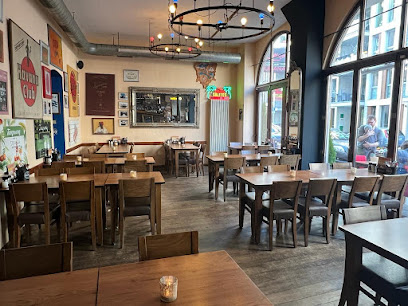
Hohenzollern Bridge: Cologne's Iconic River Crossing
Walk across Cologne's iconic Hohenzollern Bridge, adorned with love locks, for stunning cathedral views and a unique cultural experience on the Rhine.
The Hohenzollern Bridge, straddling the Rhine in Cologne, is more than just a crossing; it's a symbol of the city's resilience and a testament to enduring love. Originally built in the early 20th century to accommodate both rail and road traffic, it now stands as a pedestrian and railway bridge, offering stunning panoramic views of the Cologne Cathedral and the cityscape. The bridge has a rich history, surviving heavy damage during World War II and later reconstructed. Today, over 1,200 trains rumble across it daily, making it one of Germany's busiest railway bridges. Its pedestrian walkways are adorned with countless 'love locks,' tokens of affection left by couples from around the world, transforming the bridge into a unique and romantic landmark. Whether you're drawn to its architectural grandeur, historical significance, or the captivating display of love locks, the Hohenzollern Bridge offers a memorable experience.
A brief summary to Hohenzollern Bridge
- Cologne, Innenstadt, 50679, DE
Local tips
- Visit during sunset or the blue hour for the most spectacular views of the Cologne Cathedral and the city skyline reflected in the Rhine River.
- Bring your own 'love lock' to personalize and attach to the bridge as a lasting symbol of your affection. Locks can also be purchased and engraved in nearby shops.
- Be mindful of the train traffic when walking across the bridge, as it is still a fully operational railway bridge with over 1,200 trains crossing daily.
- Combine your visit with a walk along the Rhine promenade and explore the nearby Cologne Cathedral, Ludwig Museum, and the Old Town for a full Cologne experience.
- Consider taking a guided tour that includes the Hohenzollern Bridge to learn more about its history and significance.
Getting There
-
Walking
The Hohenzollern Bridge is easily accessible on foot from Cologne's city center. From the Cologne Cathedral (Kölner Dom), walk behind the cathedral, past the Museum Ludwig and across Heinrich-Böll-Platz. This path leads directly to the pedestrian walkway onto the bridge. The walk from the Cathedral takes only a few minutes. The bridge can also be reached from Cologne Deutz Messe station, approximately 450m away.
-
Public Transport
If arriving by public transport, the closest main station is Köln Hauptbahnhof (Cologne Central Station), which is right next to the Hohenzollern Bridge. Multiple tram and bus stops are located around the city center, within a short walking distance of the bridge. From Köln Hauptbahnhof, follow signs towards the Rhine River and the Cathedral; the bridge is directly adjacent. Subway lines also connect to Köln Hauptbahnhof.
-
Taxi/Ride-Share
Taxis and ride-sharing services can drop you off near the entrance to the Hohenzollern Bridge on either side of the Rhine. A short taxi ride from Cologne's city center to the bridge will typically cost between €9-€12. Be sure to specify 'Hohenzollernbrücke' or 'near Köln Hauptbahnhof' as your destination.
-
Driving
While you cannot drive *onto* the Hohenzollern Bridge itself (as it is for pedestrian and rail traffic only), you can drive to parking locations nearby. Parking is available in the city center, but it can be scarce. Parking lots and garages are available near Breslauer Platz and Dom/Hauptbahnhof. Q-Park Quincy offers parking at approximately €2.20 per hour, with daily rates varying from €3 (Sundays) to €7 (Monday-Thursday) and up to €12 (Fridays and Saturdays). From the parking garages, it is a short walk to the bridge.
Discover more about Hohenzollern Bridge
Iconic landmarks you can’t miss
Paolozzibrunnen – Eduardo Paolozzi (1986)
0.3 km
Discover the Paolozzi Fountain in Cologne: a captivating blend of modern art, historical remnants, and playful interaction in the heart of the scenic Rheingarten park, a short walk from Cologne Central Station.
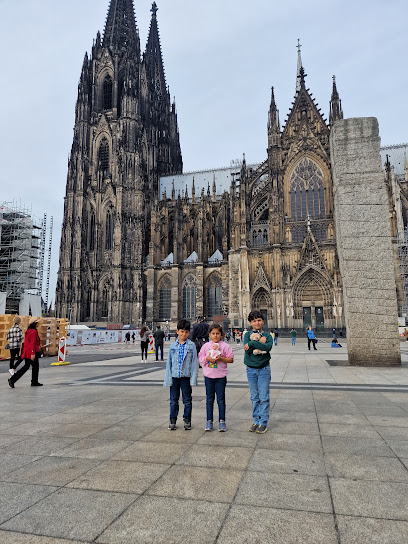
Heinrich-Böll-Platz
0.4 km
Experience Cologne's vibrant cultural heart at Heinrich-Böll-Platz, a dynamic square connecting the iconic Cathedral, Museum Ludwig, and Philharmonie, offering art, music, and stunning views.
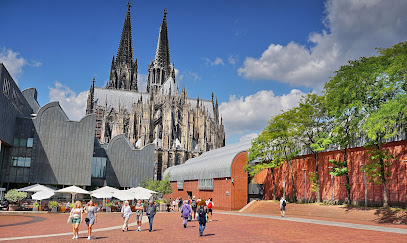
Experience Cologne
0.4 km
Explore Cologne's rich history, stunning architecture, and vibrant culture through expertly guided tours with Experience Cologne, a premier tour agency.
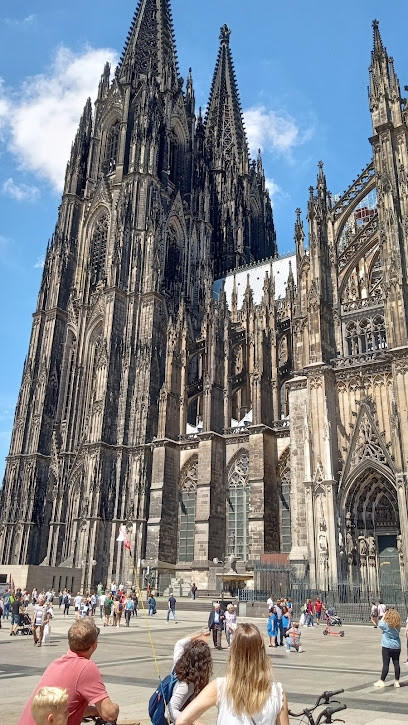
Cologne View
0.4 km
Experience Cologne from Above: Unparalleled 360° Views Await at KölnTriangle's Observation Deck, Offering a Breathtaking Perspective of the City's Iconic Landmarks and Architectural Marvels.
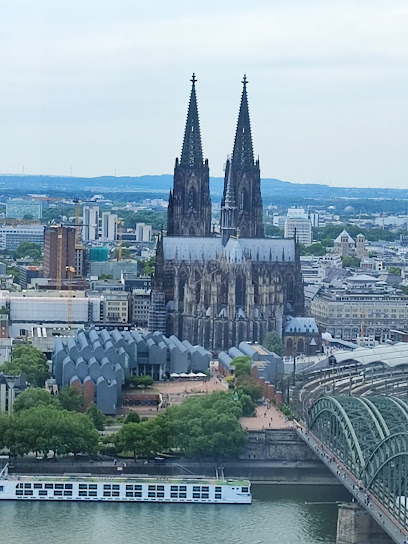
Deutz Abbey
0.5 km
Discover Deutz Abbey in Cologne: A historic Benedictine monastery offering a serene escape, Romanesque architecture, and a glimpse into the city's rich monastic past and cultural heritage.
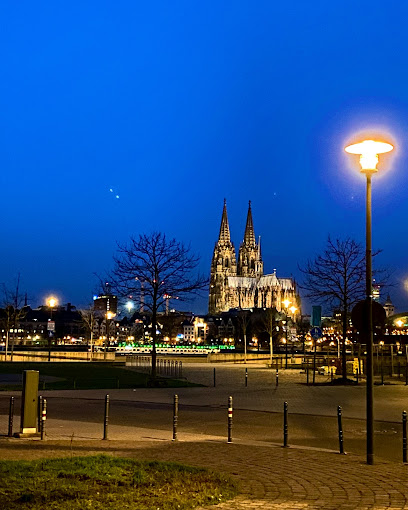
Römisches Kastell Deutz
0.5 km
Explore the remnants of Cologne's Roman fort, Divitia, a strategic outpost on the Rhine, offering a glimpse into the city's ancient past and the Roman Empire's influence.

Ancient Roman Harbor Street
0.5 km
Explore Cologne's Ancient Roman Harbor Street: A captivating historical landmark offering a glimpse into the city's Roman past, showcasing its significance as a vital trading hub.
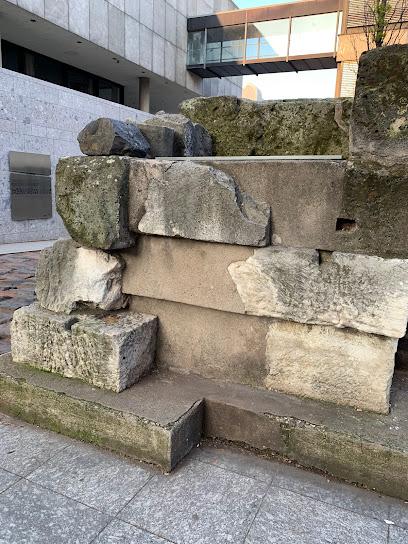
Kastell Deutz - Osttor
0.5 km
Explore the remnants of a Roman fort in Cologne-Deutz, offering a glimpse into the city's ancient past and strategic importance on the Rhine River, part of the UNESCO World Heritage Roman Limes.
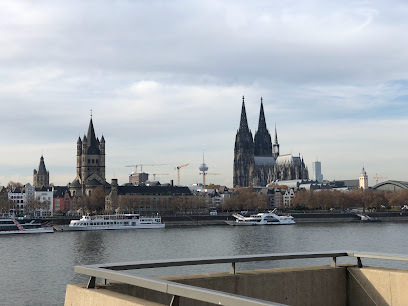
Der goldene Kupferstern
0.5 km
Experience Cologne's vibrant heart at Roncalliplatz, surrounded by iconic landmarks, bustling events, and the city's rich history and culture, offering an unforgettable adventure.
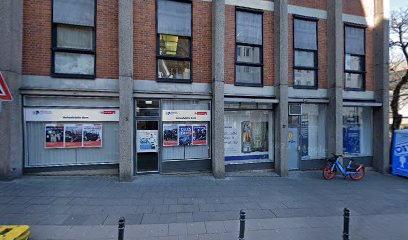
Roncallipl.
0.5 km
Experience the heart of Cologne at Roncalliplatz: where history meets vibrant culture, overlooked by the majestic Cathedral, and alive with year-round events.
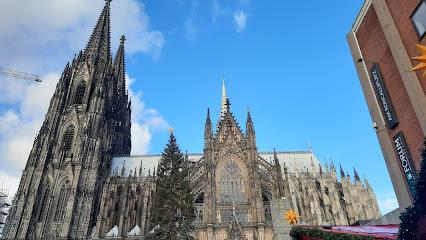
Guided Tours at the Cathedral
0.5 km
Experience the awe-inspiring grandeur of Cologne Cathedral, a UNESCO World Heritage site and Germany's most visited landmark, showcasing Gothic architecture and religious significance.
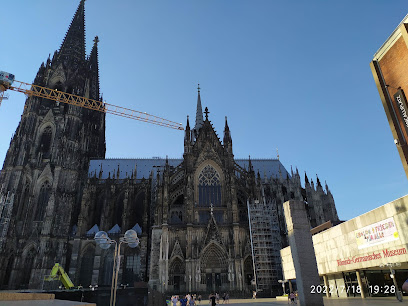
Historisches Rathaus der Stadt Köln
0.6 km
Discover Cologne's Historisches Rathaus: A captivating journey through centuries of history, architecture, and civic pride in the heart of the city's vibrant Innenstadt.
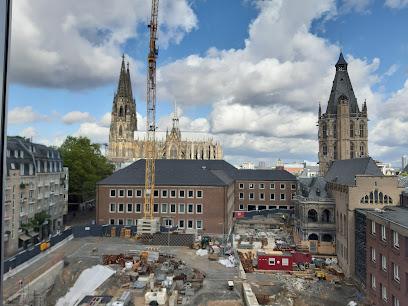
Petrusbrunnen
0.6 km
Discover the enchanting Petrusbrunnen on Cologne's Papstterrasse: a neo-Gothic fountain with a rich history and captivating charm, reflecting the city's enduring spirit.
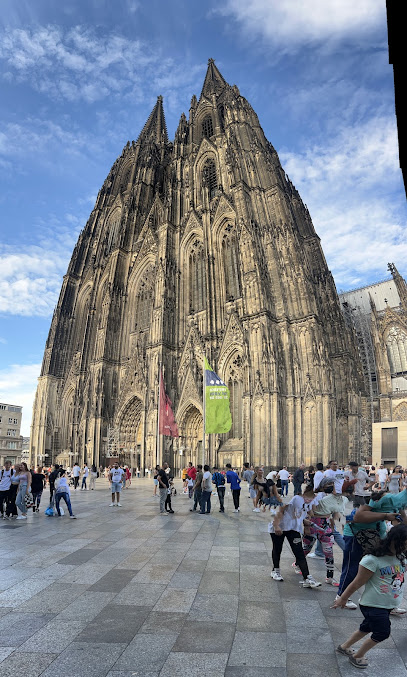
Cologne
0.6 km
Discover Cologne: A vibrant city where ancient history meets modern culture, offering iconic landmarks, world-class museums, and a lively atmosphere on the Rhine.
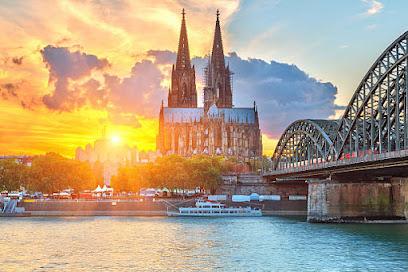
Römischer Abwasserkanal
0.6 km
Discover the ancient engineering marvel of the Römer Abwasserkanal, a historic sewer system that reveals the ingenuity of Roman civilization in Cologne.
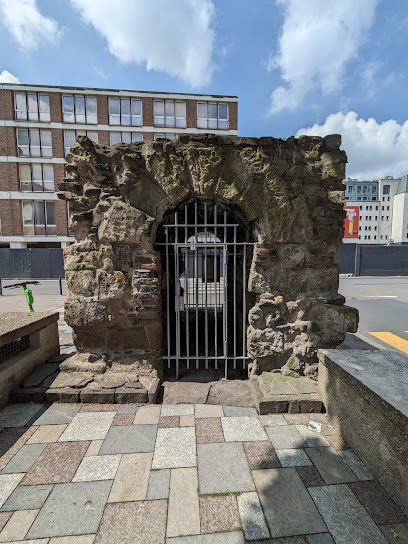
Unmissable attractions to see
KD/DSC Ticket Office Köln
0.2 km
Explore the Rhine River from the KD/DSC Ticket Office in Cologne, your premier starting point for unforgettable boat tours and stunning city views.
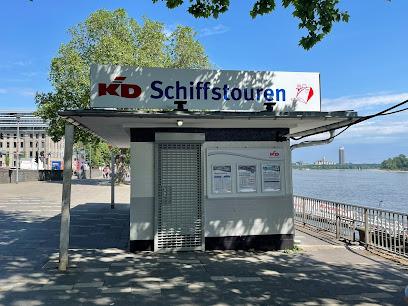
Equestrian Statue of Kaiser Wilhelm I
0.2 km
Discover the stunning Equestrian Statue of Kaiser Wilhelm I in Cologne, a magnificent cultural landmark celebrating German history along the scenic Rhine River.
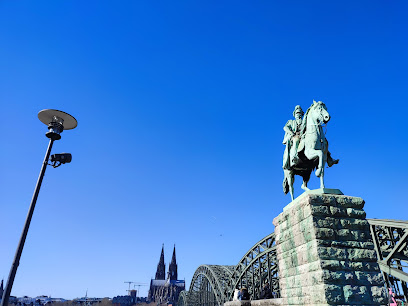
Rheinufer
0.2 km
Experience the breathtaking views and vibrant atmosphere at Rheinufer, Cologne's scenic riverside promenade, perfect for relaxation and exploration.
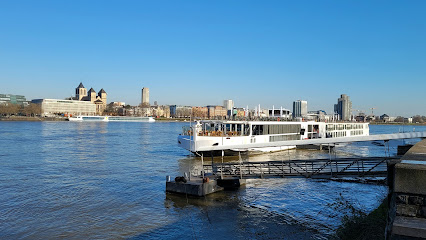
Equestrian Statue of Kaiser Wilhelm II
0.2 km
Discover the grandeur of the Equestrian Statue of Kaiser Wilhelm II, a cultural landmark in Cologne offering stunning views and rich history.
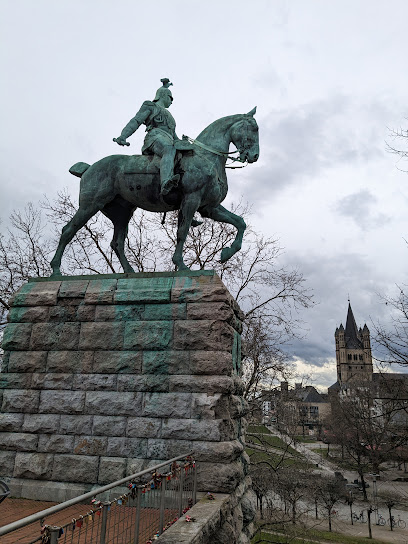
Rheinpromenade Köln-Deutz
0.3 km
Experience the vibrant atmosphere and breathtaking views of Cologne's skyline along the scenic Rheinpromenade in Köln-Deutz.

Rheingarten
0.3 km
Discover the beauty of Rheingarten, a tranquil park along the Rhine River in Cologne, perfect for relaxation, recreation, and unforgettable views.
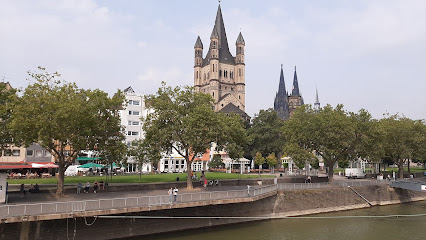
MA'ALOT
0.3 km
Explore MA'ALOT, a stunning sculpture in Cologne's picturesque Heinrich-Böll-Platz, where art and culture flourish in the heart of the city.
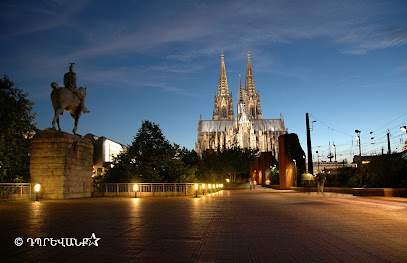
Cologne Philharmonie
0.4 km
Experience the magic of music at Cologne Philharmonie, a world-class concert hall in the heart of Cologne, Germany, known for its stunning architecture and acoustics.

KD Deutsche Rheinschiffahrt GmbH
0.4 km
Explore the beauty of the Rhine River with KD Deutsche Rheinschiffahrt, offering unforgettable boat tours in the heart of Cologne.

Rheinboulevard
0.4 km
Experience breathtaking views and vibrant atmosphere at Rheinboulevard, a must-visit scenic promenade along the Rhine River in Cologne.
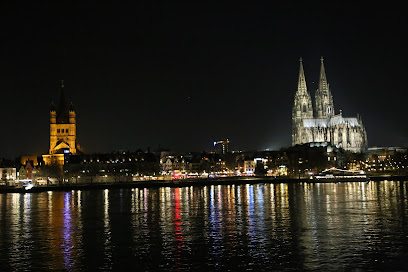
Museum Ludwig
0.4 km
Explore the vibrant world of modern art at Museum Ludwig, Cologne's premier destination for contemporary masterpieces and cultural experiences.
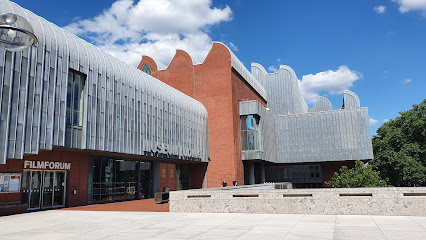
Frankenwerft
0.4 km
Experience the picturesque charm of Frankenwerft in Cologne, where stunning riverside views meet rich history and vibrant local culture.

Fischweiber-Brunnen (Rainer Walk, 1986)
0.4 km
Explore Cologne's rich heritage at the Fischweiber-Brunnen, a stunning fountain honoring the city's historic fish trade and vibrant local life.
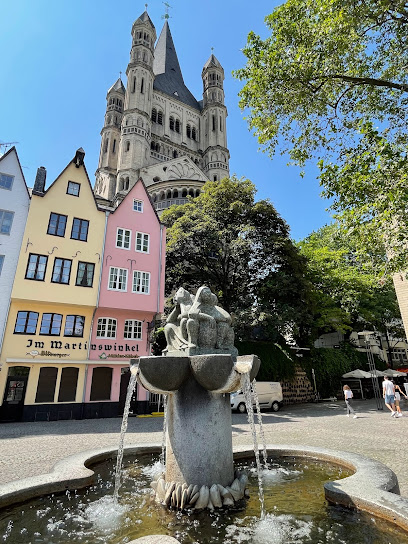
Tierbrunnen, Köln - Theo Heiermann & Elmar Hillebrand (1980)
0.4 km
Explore the artistic charm of Tierbrunnen, a stunning fountain in Cologne that captures the essence of the city's vibrant cultural heritage.

Fish Market
0.4 km
Discover the lively Fish Market in Cologne, where fresh seafood and local flavors create an unforgettable culinary experience amidst stunning riverside views.
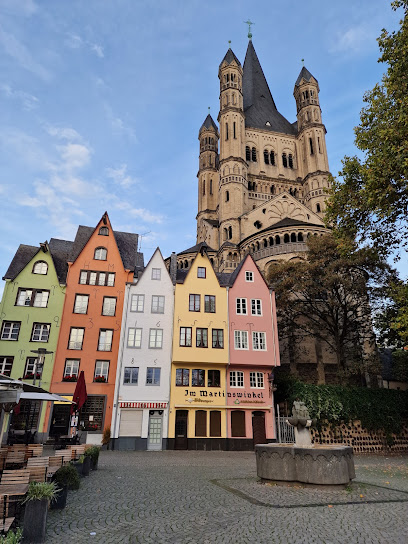
Essential places to dine
Grissini Restaurant & Terrasse
0.2 km
Experience the taste of Italy with stunning river views at Grissini Restaurant & Terrasse in Cologne.
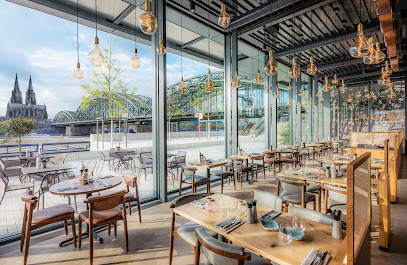
Sticky Fingers Restaurant & Terrasse
0.3 km
Experience delicious American cuisine at Sticky Fingers Restaurant & Terrasse in Cologne – perfect for families and friends overlooking the Rhine River.
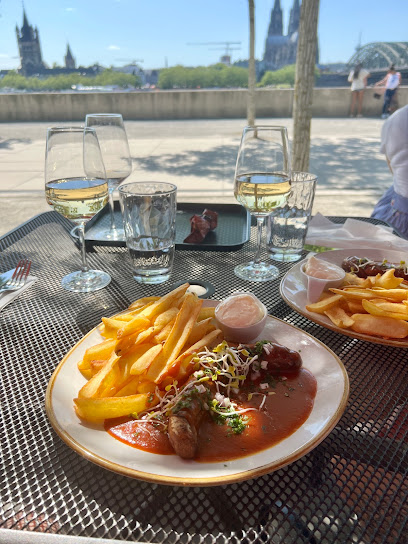
Glashaus Restaurant
0.3 km
Experience exquisite dining at Glashaus Restaurant, where contemporary design meets exceptional cuisine along the scenic Rhine River in Cologne.
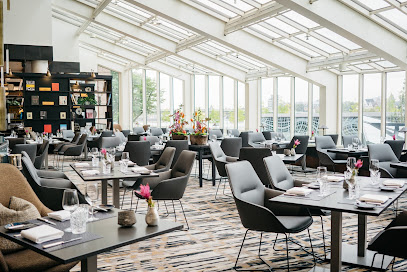
Restaurant maiBeck
0.3 km
Experience innovative bistro cuisine in Cologne at Restaurant maiBeck - where local flavors meet culinary creativity.

Em Krützche
0.3 km
Savor traditional German flavors at Em Krützche, a charming inn and restaurant in the heart of Cologne's Innenstadt district.
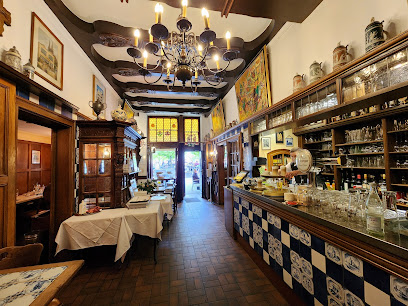
RheinZeit
0.3 km
Experience authentic German cuisine at RheinZeit in Cologne, where tradition meets modern dining in a vibrant atmosphere.

Ludwig im Museum Restaurant & Café
0.4 km
Experience culinary excellence at Ludwig im Museum Restaurant & Café in Cologne - where art meets flavor in a vibrant setting.
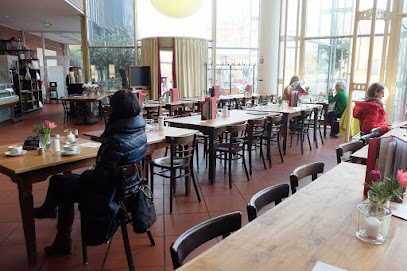
Peters Brauhaus
0.4 km
Discover Peters Brauhaus in Cologne - A lively brewpub serving authentic German cuisine and craft beers in an inviting atmosphere.
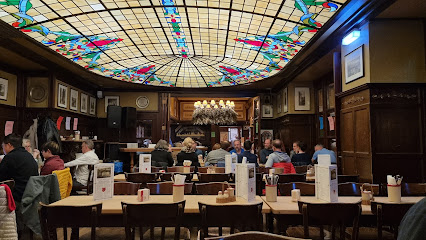
Restaurant Mama Leone
0.5 km
Savor authentic Italian flavors at Restaurant Mama Leone in Cologne – where every meal is a celebration of taste and tradition.
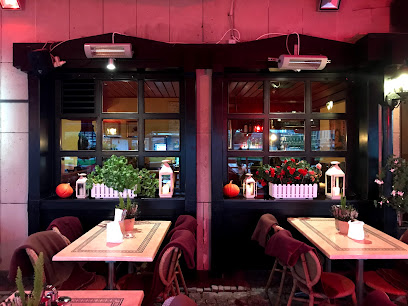
Mongo's Restaurant Köln - Deutz
0.5 km
Experience authentic Mongolian barbecue and Asian flavors at Mongo's Restaurant Köln - Deutz; perfect for food lovers seeking diverse cuisine.
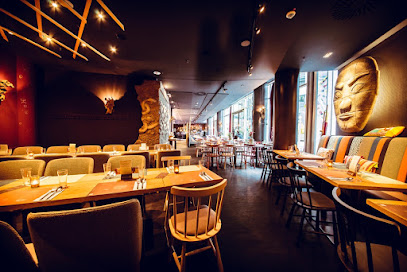
Haxenhaus
0.5 km
Experience authentic German flavors at Haxenhaus in Cologne – where tradition meets taste by the Rhine River.
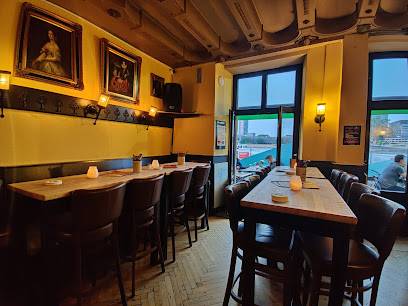
Brauhaus Sünner im Walfisch
0.5 km
Experience Cologne's brewing tradition at Brauhaus Sünner im Walfisch – where authentic flavors meet local charm.
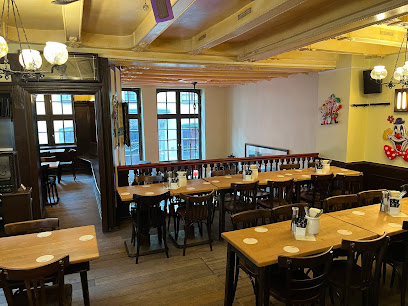
Kaiser Konstantin - Kölsches Brauhaus
0.5 km
Discover authentic Kölsch beer and traditional German cuisine at Kaiser Konstantin - Kölsches Brauhaus along the beautiful Rhine River in Cologne.
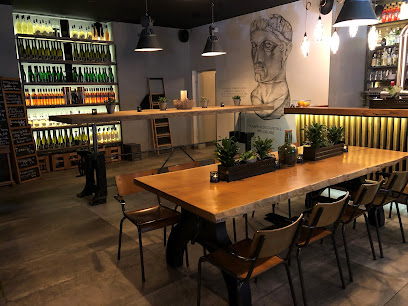
HACIENDA
0.5 km
Experience the vibrant flavors of Argentinian cuisine at Hacienda in Cologne - a perfect blend of tradition and innovation.

Keule
0.5 km
Experience authentic German flavors at Keule in Cologne - where tradition meets modern culinary artistry.
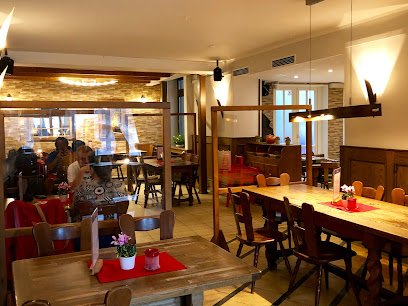
Markets, malls and hidden boutiques
Domkloster 4 GmbH
0.6 km
Explore the heart of Cologne at Domkloster 4 GmbH, your go-to gift shop for unique souvenirs and local crafts that embody the city's spirit.
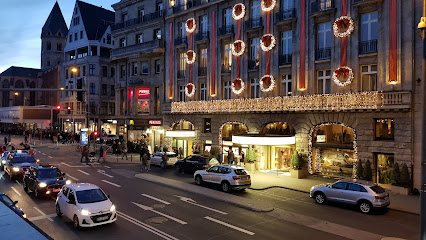
Grow Shop Cologne plant breeding
0.6 km
Explore a lush paradise at Grow Shop Cologne, your go-to destination for plants, gardening supplies, and expert advice in the heart of the city.
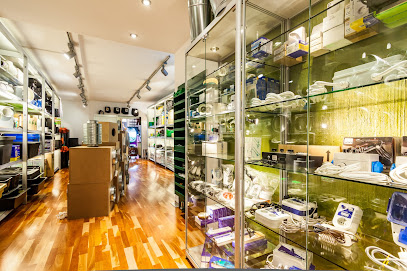
Eckert
0.6 km
Explore Eckert, Cologne's vibrant hypermarket offering everything from fresh bakery items to books, perfect for tourists seeking convenience and local flavor.
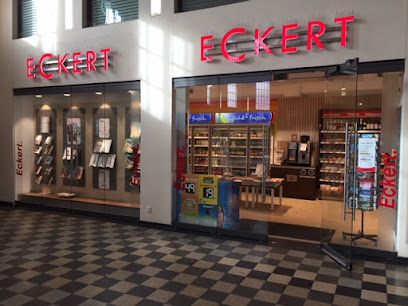
Früh Shoppen
0.6 km
Explore Früh Shoppen in Cologne for a delightful shopping experience filled with local treasures and unique finds.
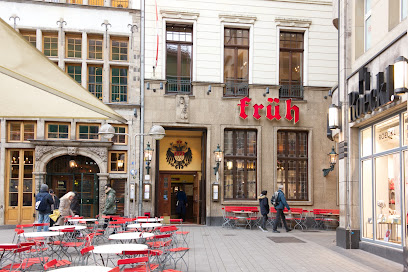
Einkaufsbahnhof Köln Messe-Deutz
0.6 km
Discover a vibrant shopping experience at Einkaufsbahnhof Köln Messe/Deutz, where fashion meets food in the heart of Cologne.

LOUIS VUITTON Cologne Store
0.6 km
Explore the luxury of Louis Vuitton in Cologne, featuring exquisite leather goods and fashion accessories in a stunning retail environment.
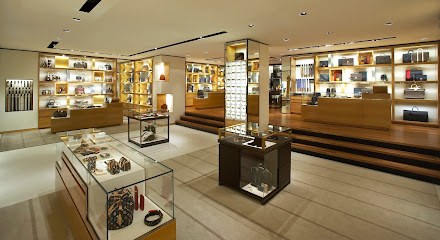
Victorinox Store Köln
0.7 km
Discover Swiss quality at the Victorinox Store in Cologne, featuring iconic knives, stylish luggage, and exclusive apparel in a modern shopping atmosphere.
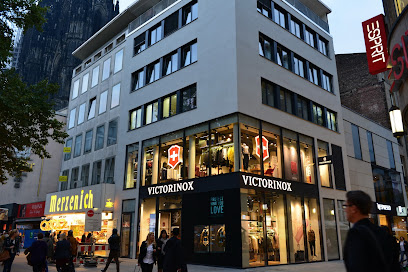
4711 Shop am Dom
0.7 km
Explore the iconic 4711 Shop am Dom in Cologne, where history meets modern fragrance in a delightful gift shopping experience.
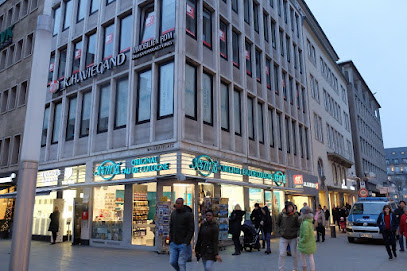
Close Up GmbH
0.7 km
Explore Close Up GmbH: Cologne's premier gift shop for unique posters and artistic treasures in the heart of the city.
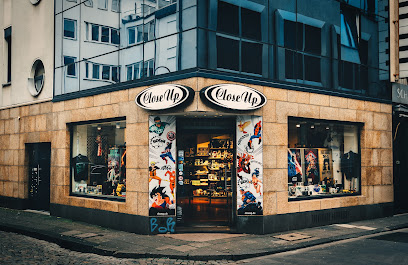
Montblanc Boutique
0.7 km
Discover timeless luxury at Montblanc Boutique in Cologne, home to exquisite writing instruments and elegant leather goods.
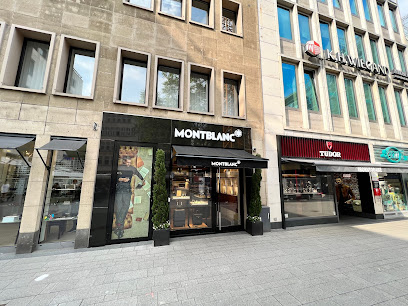
BVLGARI
0.7 km
Explore BVLGARI in Cologne for an exquisite range of luxury jewelry, fashion accessories, and timeless leather goods in a sophisticated setting.
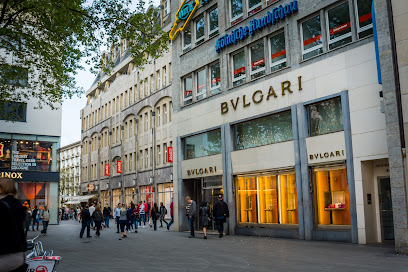
Pylones
0.7 km
Explore Pylones in Cologne for unique gifts and home goods, filled with creativity and playful designs to brighten your day.

German Souvenirs
0.7 km
Explore authentic German gifts and souvenirs in Cologne's charming gift shop, perfect for tourists seeking unique mementos.
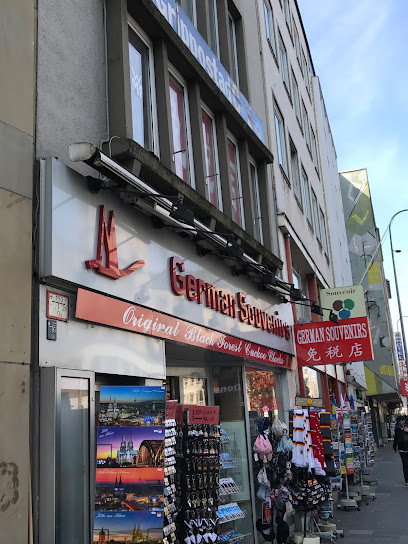
Casado Store
0.7 km
Discover the heart of Cologne's fashion at Casado Store, where style meets elegance and every piece is a statement.

Elbenwald
0.7 km
Explore the enchanting Elbenwald gift shop in Cologne, where fantasy meets shopping with clothing, toys, and unique gifts for all ages.
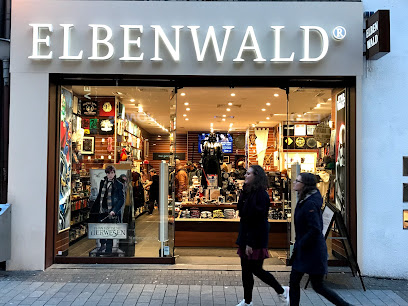
Essential bars & hidden hideouts
Legends Bar & Terrasse
0.2 km
Experience the ultimate cocktail bar in Cologne with stunning Rhine views, sophisticated atmosphere, and expertly crafted drinks at Legends Bar & Terrasse.
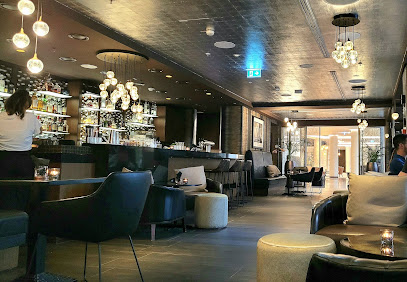
Sonderbar - Köln
0.5 km
Experience the best local brews and a vibrant atmosphere at Sonderbar, a must-visit bar in the heart of Cologne.
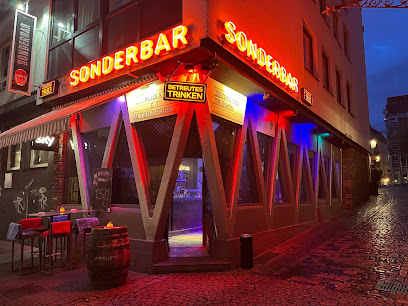
Papa Joe's Biersalon
0.5 km
Experience the vibrant pub culture of Cologne at Papa Joe's Biersalon, where great beer and hearty meals await in a lively atmosphere.
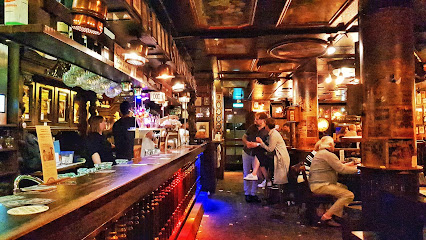
die kunstbar
0.5 km
Discover Die Kunstbar in Cologne: A vibrant bar blending art, music, and delicious drinks in the heart of the city’s nightlife.
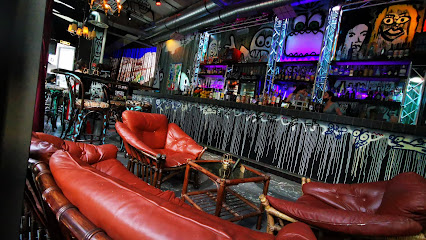
The Corkonian Irish pub
0.5 km
Experience the heart of Ireland at The Corkonian Irish Pub in Cologne, where traditional food, drinks, and live music create unforgettable memories.

Plüsch Bar & Lounge (im Köln Marriott Hotel)
0.5 km
Experience luxury and relaxation at Plüsch Bar & Lounge in Cologne, where exquisite cocktails and elegant ambiance await you.
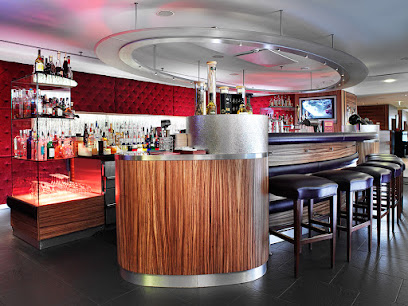
Barney Vallely's
0.5 km
Discover the essence of Ireland at Barney Vallely's, a lively pub in Cologne with authentic food, drinks, and vibrant entertainment.

Bierbaum
0.5 km
Discover the lively Bierbaum bar in Cologne, where great drinks and a welcoming atmosphere blend seamlessly for an unforgettable night out.
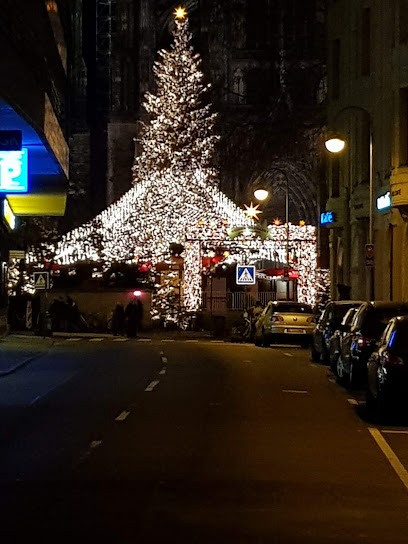
The Copper Pot - Köln
0.7 km
Experience Irish hospitality at The Copper Pot in Cologne, where lively ambiance, delicious cocktails, and live music await every visitor.
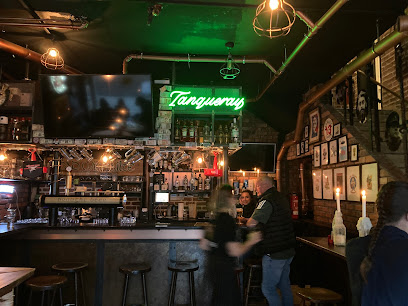
km 689 Cologne Beach Club
0.7 km
Discover km 689 Cologne Beach Club, where vibrant beach vibes meet lively nightlife on the banks of the Rhine.
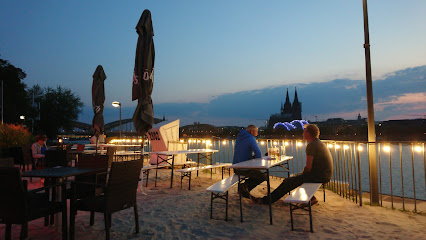
CAFE ESPECIAL Köln
0.7 km
Experience authentic Mexican flavors at Café Especial in Cologne, where vibrant dishes and a lively atmosphere create unforgettable dining moments.

Piano Bar
0.7 km
Discover the enchanting Piano Bar in Cologne, where signature cocktails, live music, and a chic atmosphere create a perfect nightlife experience.
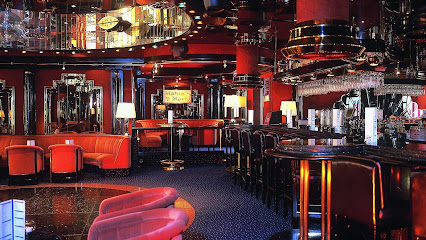
Constantin Pub
0.7 km
Discover the vibrant atmosphere and local charm of Constantin Pub, a must-visit destination for drinks and socializing in Cologne.
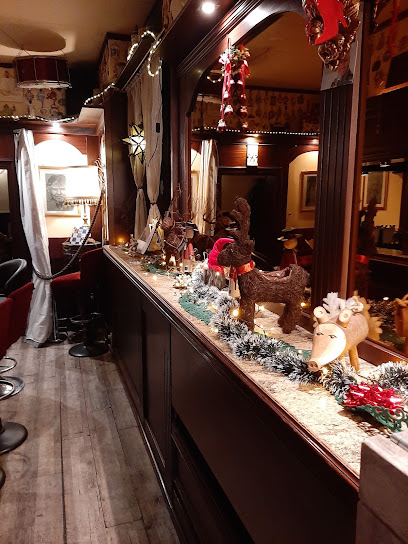
other side - bar'n'kitchen
0.7 km
Experience the best of Australian cuisine and local drinks at other side - bar'n'kitchen in Cologne's lively Innenstadt.
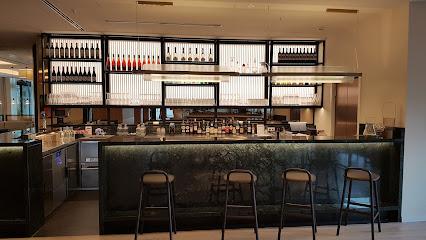
Latino Cubana
0.8 km
Discover the authentic tastes of Cuba at Latino Cubana, Cologne's premier Cuban restaurant and cocktail bar, where every bite is a celebration of flavor.
